
It’s a short post today folks, since it’s another week of trying to catch up here… but before we get to that, just really brief Thunderbean news:
We’ve been lucky to start some ad campaigns on Amazon; these extra sales are really helping to move other projects forward, and there’s a bunch of them! The big goal in the coming months is to find enough time (and have enough help) to catch up on everything and get some more sets finally out. Hang tight with us for a few— we’re getting there. Off to Toronto later this week to scan almost the last of the first half of the Rainbow Parade series… adding the other two ‘Toddle Tales’ with original titles, thanks to Tommy Jose Stathes.

Now, onto Famous Studios! Today’s cartoon is Saved By The Bell (1950).
I’ve been getting double and triple doses of Famous Studios shorts, watching the new WB Popeye set as well as cleaning up Noveltoons- and its both an enjoyable and disturbing experience. I feel like Famous is the only studio that seems to take great joy in painful events happening to the characters, often seemingly beyond the slapstick nature of cartoonish gags and into the very real territory of actual pain. The more disturbing (and actually funny) thing to me is that they’re willing to do it over and over in one cartoon, oblivious to the face that they’ve actually gone too far.
It’s easy to think that as formulas developed, the studio relied on slapstick gags and increased the violence out to sheer need for inventiveness. There may be some truth in that, but I think the studio really had been going that direction since Shorty was shot (in Happy Birthdaze (1943)), a moment that shocked me as a child and really seemed ‘off’. Now, I had experienced many Warner cartoons and others where violent things happened, but it always felt like a gag. Somehow, people killing his friend just doesn’t in this cartoon. There would be a lot more of those moments in the coming years.
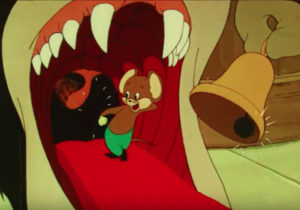 Perhaps most of the characters never having true star power led to the conclusion to have them just be vehicles for violent slapstick gags. It worked for Tom and Jerry, so why not our characters? The odd thing about the Famous cartoons is that there is rarely, if at all, a moment of empathy for any of the characters, good or bad. It just doesn’t happen. The Tom and Jerry (and the majority of the Warners cartoons) contain all sorts of character insight moments; Avery’s cartoons rarely do, but they are either strong enough on gags and timing to make those areas non-essential. If a character is having feelings in one direction or another, it’s a momentary takeover of their psyche, often never followed up on. In the context of a 7 minute cartoon, that actually works quite a bit of the time as the story sweeps up further form those moments, but in terms of developing a character it leaves us little to remember or like.
Perhaps most of the characters never having true star power led to the conclusion to have them just be vehicles for violent slapstick gags. It worked for Tom and Jerry, so why not our characters? The odd thing about the Famous cartoons is that there is rarely, if at all, a moment of empathy for any of the characters, good or bad. It just doesn’t happen. The Tom and Jerry (and the majority of the Warners cartoons) contain all sorts of character insight moments; Avery’s cartoons rarely do, but they are either strong enough on gags and timing to make those areas non-essential. If a character is having feelings in one direction or another, it’s a momentary takeover of their psyche, often never followed up on. In the context of a 7 minute cartoon, that actually works quite a bit of the time as the story sweeps up further form those moments, but in terms of developing a character it leaves us little to remember or like.
Popeye remained an interesting character through a lot of the 40s films in that he maintained his sense of humor about others throughout these films, only later giving in to his base emotional responses as a character. The Fleischers always had moments of Popeye on his own, doing some bit of business for self amusement, or just being bemused or amused b what he had just done.
Saved By the Bell (1950) is a great example of Famous Studios attitude toward storytelling. Throughout the film, it’s not only a good idea to have gags be violent, it’s preferable to have *every* gag involve great pain caused by another.
Somehow at MGM, Jerry Mouse, though incredible acts of violence to Tom, never comes off as such a mean character – even if he’s been drinking or getting Tom kicked out of the house.
At Famous, the best any of these characters seems to get is obnoxious, and at worst, a sadist. It wasn’t enough to put the bell on the cat, it was also required to have him in great pain throughout the process, and insanity by the end of the cartoon! The slickness of production in the Famous Shorts sometimes makes these choices even more puzzling.
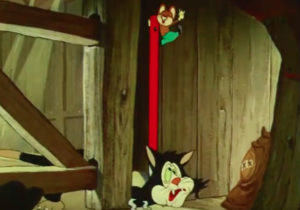
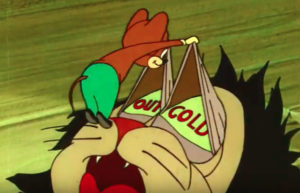
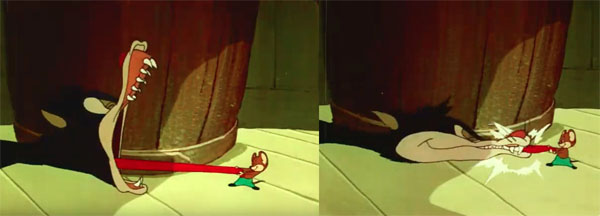

That isn’t to say that I don’t like a lot of these ideas. I find them to be really fun and funny, but also have the understanding that they really do go a little too far, almost always.
Here’s the work in progress version of Saved By the Bell from the upcoming Thunderbean Noveltoons Blu-ray. Nothing beats beautiful old Technicolor prints of these shorts, though most of the existing prints have been beat up a lot. Still, they look better than most if not all of any other copies available.
What are some of YOUR most uncomfortable moments of violence in Famous Studios cartoons? Submit your answers in the comments section below.
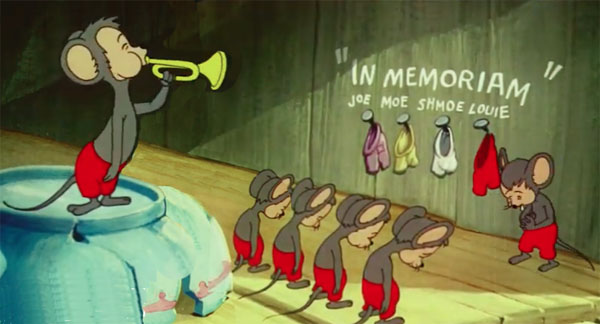


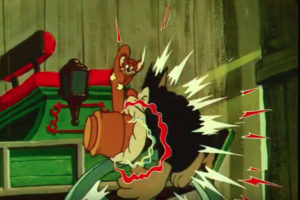
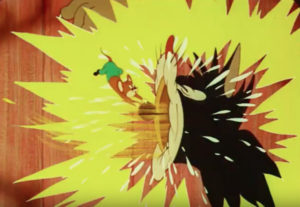
 Steve Stanchfield is an animator, educator and film archivist. He runs Thunderbean Animation, an animation studio in Ann Arbor, Michigan and has compiled over a dozen archival animation DVD collections devoted to such subjects at Private Snafu, The Little King and the infamous Cubby Bear. Steve is also a professor at the College for Creative Studies in Detroit.
Steve Stanchfield is an animator, educator and film archivist. He runs Thunderbean Animation, an animation studio in Ann Arbor, Michigan and has compiled over a dozen archival animation DVD collections devoted to such subjects at Private Snafu, The Little King and the infamous Cubby Bear. Steve is also a professor at the College for Creative Studies in Detroit.






















I wince whenever I see Buzzy fire a pistol at Katnip’s teeth in “No Ifs, Ands or Butts” (1954).
-She-Sick Saliors- Bluto as Superman trying to “shoot” Popeye
-Parles Vous Woo- Bluto as The International trying to “stab” Popeye
-Chew Chew Baby and Pop-Pie A-La Mode
Most of the violence in Herman and Katnip aren’t as painful, I’m sorry. I know better.Maybe I should bring my DVD and watch it again.
The closing gag in “One Quack Mind” (with the shotgun pellets and the player piano) is definitely the most morbid. The grisliest is probably the straight razor boomerang gag in “Jumping with Toy”.
I dunno. I believe this studio simply did not have the skills, or mindset, to make pratfalls and slapstick FUNNY; ie, they couldn’t WRITE. There is evidence going back to the 30s. There are at least a couple Betty Boops where little “torture chambers” are created to correct bad guys; inventive to a degree, but terribly UNfunny.
Popeye is an exception, via his personality as noted. Bluto is often uncomfortably violent, and Popeye returns the favor, but with his trademark mumbling and cleverness – that’s funny. And somehow, Popeyes stepped up in the late 30s – early 40s with speed and visuals. But they ran out of gas; 50s Popeyes aren’t very much fun.
Herman/Katnip, Baby Huey, Buzzy etc, cannot generate slapstick comedy. Casper is outright dreary. Ironically, the otherwise fluid animation and other high production values of that studio only drive home the unfunniness.
Comedy is serious business.
I’m glad you brought up Bluto. Famous’ Bluto is especially sociopathic in the post-1948 Popeyes. A good example is How Green Is My Spinach(1950). After Bluto eliminates all of the world’s spinach, he then mercilessly beats up a weakened, helpless Popeye in a supermarket. That sequence exemplifies the uneasy, uncomfortable violence of Famous.
Don’t forget “Winner By A Hare” gag at the end with Moe Hare blowing his brains out.
And then his ghost popping out of the grave and pulling the ground over him with a THE END on the tombstone!
Two uncomfortable examples come to mind:
1) In the Herman & Katnip cartoon “Herman the Cat-toonist” when Herman cuts Katnip’s head off with a pair of scissors
2) I can’t recall exactly which cartoon it is from, but definitely a Famous Studios one, which really made me squirm seeing it as a kid: A spaceman is wandering around the city streets near the beginning of the cartoon and comes across a barking dog. He shoots his space gun at the animal leaving an animated skeleton still moving as if it were still barking, but now silent…. eeeerrrggg…
I could go on about the Huey cartoons (like when Huey rips the fur off the fox’s head in “One Quack Mind”, or when he blows up the fox’s head and the facial elements fly up in the air, and land in pieces back on the head….
The Noveltoon you are thinking of, Larry T., is “Out of This Whirl” (1959)
The barking skeleton dog freaked me out. As a kid
Katnip shrieking over becoming blind.
Yeah, I remember that one. Katnip is thrown against a stuffed animal exhibit and the artificial eyes pop out of the creature’s head. Katnip thinks they’re his OWN eyes and shoves them into his eye sockets. Then runs around hysterically screaming “I can’t see!” Even as a kid I thought that was so frickin’ wrong!
Same here. That one seriously wigged me as a kid, and still bothers me now to think about it.
Yeah Mouseum from 1956. That one stayed with me as an adult especially how Katnip screams, “MY EYES!”.
https://www.dailymotion.com/video/x37ded9
This is probably TMI, but… whenever a character is impaled in the rear end, or otherwise nastily accosted in that region of the body, I feel a corresponding empathetic tingle in my own tailbone!
“Puppet Love” on the new Popeye disc: After Bluto uses a Popeye marionette to torment Olive, Popeye knocks Bluto out and makes HIM a marionette. We then get puppet Bluto, with a creepy semi-conscious expression, holding a huge knife at terrified Olive’s throat. Popeye drops down from the tree to whale further on helpless Bluto.
The tone thing is so weird, and so unique to Famous. Creepy to imagine a screening room full of adults laughing at them; more likely a bunch of unsmiling managers nodding and saying, “Yeah. Research says kids love this ****.”
Terrytoons had their own form of creepy: Cats would regard mice as food in one cartoon and sex objects in another. Put a few together and you’ve got major uneasiness.
Ever since I was a kid its always been the scenes in looney tunes involving almost executions…..With guillotines, gallows, axes etc……Theres a few very terrifying seconds in some of those where the Antagonist is building a guillotine in the shadows with a hammer with the protagonist all tied up and looking terrified at what we cant see……. Still send chills down my spine.
The big splice at the ending gag of the picture! Hope you got a spare scan to replace…. also, those warm greens and the green haze overall on this element is something.
Honestly, I never minded the violent acts portrayed in Famous Studios cartoons in and of themselves. Having grown up in the age of South Park and Family Guy where far more graphic violence, often with bloodshed, is readily available at my fingertips, the stuff Herman does to Katnip, for example, doesn’t feel any more violent compared to Daffy getting shot in the face or Tom getting his tail chopped off. If anything, my fault with the Famous’s brand of slapstick is the execution. For all the flack they get for their violence, the shorts’ sluggish pacing and mushy timing makes the violent gags less effective, since (ironically) the gags don’t really look or feel all that painful, though like Steve mentioned, the paper thin personalities of the Famous cast really didn’t help. But that’s just me, and I don’t really get upset over any supposed “mean-spiritedness” (GOD I hate that term! Waaay to overused…) like certain other animation fans I know of do.
Although not an animated cartoon, National Lampoon magazine did a spoof of Herman and Katnip comics, called Kit and Kaboodle, and it is choc-a-block with the most violent imagery imaginable, with real-world consequences (broken spines, severed limbs, etc., and lots of blood!). Pretty sick, but not much worse than the Famous Studios cartoons!
The thing about Warner’s and MGM’s cartoons, they had ridiculous outcomes that really softened the violence – Tom gets hit in the face with a frying pan and becomes a coffee table! Spike gets shot in the mouth and his shattered teeth form an igloo on his tongue! Elmer shoots Daffy in the face and his bill spins around on it like a top!
The most uncomfortable Famous Studios moment for me was the “cheaper by the dozen” gag from POPEYE’S PAPPY (1951). Usually, the racial gags in these cartoons never bothered me all that much, but that specific gag for some reason actually made me wince.
As a side note, Itchy and Scratchy is actually not a parody of Tom and Jerry, it’s actually a parody of Herman and Katnip. So in a way, Itchy and Scratchy are making fun of Tom and Jerry’s imitators, due to the fact that the Tom and Jerry imitators never understood why the slapstick violence works. I’d also argue that the people working on the new Tom and Jerry material actually don’t know the characters, they only know about the violence and slapstick.
You do know Greg wrote an episode for one of the recent shows, right? I know he understands how these characters work.
Speaking of which, I recall Maltin writing in “Of Mice and Magic” that he wasn’t too keen on “Cueball Cat” where he called it “imagination in violence”. Although, I thought that short was well-set up and would like to have a Hallmark ornament based on that short.
The Tom and Jerry Show is awful, but its biggest problem is the cheap and ugly-looking digital cut-out animation. That medium just doesn’t work for these characters.
As for the recent direct-to-video features helmed by Spike Brandt and Tony Cervone… I think Spike and Tony showed in the previous decade that they have a better understanding of Bill and Joe’s cat and mouse than the majority of others who have tried doing new material with them. Their 2000s output wasn’t perfect, but I think “The KarateGuard” and “A Nutcracker Tale” touched upon classic T&J more than any modern production prior to them. (That said, some of the “Tom and Jerry Tales” episodes by other directors were fairly entertaining too.) From 2010, however, Brandt and Cervone were clearly required to make crossover films where Tom and Jerry meet every other Warner franchise under the sun rather than just make Tom and Jerry cartoons. Pity.
By the way, come to think of it… there was no new direct-to-video Tom and Jerry feature in 2018. What happened with that? They have been coming out steadily every year since 2010. Was the negative reception to the 2017 Willy Wonka feature (which went viral and made the world at large realize that these crossover T&J films actually exist) so overwhelming that Warner decided to just can the series?
I thought the two written by the late Earl Kress (his last one with Robin Hood was better than one of last CinemaScope shorts with Robin Hood, in my opinion) and the “Beanstalk” one by Dini were well done. You just need the right writers for these jobs. Again, I think you could Greg a chance with his episode (I forgot which one he wrote but it’s listed on his site).
Also, I think they are done with the “Tom & Jerry” features partly due to the changing home release landscape (streaming).
“I thought the two written by the late Earl Kress (his last one with Robin Hood was better than one of last CinemaScope shorts with Robin Hood, in my opinion) and the “Beanstalk” one by Dini were well done. You just need the right writers for these jobs. Again, I think you could Greg a chance with his episode (I forgot which one he wrote but it’s listed on his site).”
“Tom and Jerry Meet Robin Hood” is one of those I haven’t seen, but maybe I’ll check it out. I thought the “Sherlock Holmes” movie written by Kress was fairly decent, and certainly done with good intentions. But of course, it wasn’t really satisfying as a Tom and Jerry film. None of these are. The “right writers” will not solve all the problems here. The whole concept of shoehorning Tom and Jerry into other Warner franchises is fundamentally flawed.
When it comes to the Dini-scripted “Beanstalk” movie, I think it ranges from fun and entertaining to awful. There was some great animation of the giant in his song number, and I’ll also give the film bonus points for including Red in an attire very close to her debut appearance in “Red Hot Riding Hood” (and with her own song number to boot!). On the other side of the spectrum were the terrible, saccharine moments, like Jack’s “I want” song during the first part of the film. When I was watching that, I thought to myself, “Oh god… we are RIGHT back in Tom and Jerry 1992 Movie land! The only thing missing is Tom and Jerry speaking!” This is what makes these crossover films so frustrating to watch. On the one hand, they are done by people with a great love for and understanding of the classic MGM cartoons and characters; on the other hand, they need to squeeze in the sensibility and style of the OTHER franchise they are working with, so fans of THAT movie or series will not go unsatisfied. Result: neither party is really satisfied. I don’t even know if the T&J Beanstalk movie is specifically adapting a Warner Bros. production of “Jack and the Beanstalk”, but I guess it is, and that the argument for including such a terrible number as Jack’s song came from there.
By the way, who is “Greg”? You keep referring to him by his first name as if everyone knows who he is, but I don’t.
“Also, I think they are done with the “Tom & Jerry” features partly due to the changing home release landscape (streaming).”
Perhaps, but other Warner direct-to-video franchises are continuing right on as before (for instance Scooby-Doo). So I don’t think that’s the whole explanation. And in any case, streaming has become a lucrative medium in its own right. Most direct-to-video features these days are produced with SVOD and VOD releases in mind as much as anything else.
Woops, wrong title on the Robin Hood movie! I see now that the correct title is “Tom and Jerry: Robin Hood and His Merry Mouse”.
Contributor Greg Ebhar who might feel hurt if you criticize and over-analyze his work just like you did with everything else. Just be glad that they didn’t cross-over with another popular H-B property yet (actually, that might not be a bad thing if Sholly Fisch did just that in the Scooby cross-over comic or former Disney alumni Chris Baily (“Runaway Brain”, “Kim Possible”) used them as guest star in an episode for his upcoming “Scooby-Doo and Guess Who” series, although I’m not exactly sure how those would play out).
Please spare me that crass, condescending tone, Nic. “…if you criticize and over-analyze his work just like you did with everything else”…? I gave clear and concise explanations as to why I find the Tom and Jerry crossover features problematic, and also made it clear that I don’t think the writers of the films are the main problem. Instead of actually responding to my criticism, you just dismiss it as “over-analysis” — as if this stuff is not worth taking seriously enough to critique properly. But if it isn’t, why is my criticism bothering you to begin with?
I know who Greg Ehrbar is, but I did not know he had written an episode of The Tom and Jerry Show (which I only found out by checking his site, as you didn’t specify anything further than “an episode”). As such, I couldn’t be sure that it was the same Greg earlier. It might be an idea to be more specific rather than just assume everyone who’s commenting on a public blog knows exactly what you’re talking about.
Also, please stop talking in hurt and offended terms on behalf of other people. As you seem to be unaware of, everyone working in a creative field “risk” having their work talked about, dissected and analyzed. It’s simply part of the game. Speaking of writers again: I greatly admire Paul Dini as a writer, but that doesn’t mean everything he touches becomes gold. If you can’t deal with critisism of material that you had no involvement with yourself, I don’t know what you’re doing in the comments section of a site where all things animation are routinely discussed and analyzed.
Well, you are doing it more than me I think.
Doing what exactly? Addressing you in a cross, condescending tone? Or talking in hurt and offended terms on behalf of other people? Whatever the case, I’ll have to disagree — I don’t see myself doing either here. The reason I’m talking about this now is the condescending tone of your previous comment.
It’s obvious that you don’t want any real criticism of stuff that you happen to like, and I’m sorry to have to say it, but the world doesn’t work like that. People have different opinions. I’m simply voicing mine, and I wish you’d do the same without resorting to snide, personal remarks and dodging the topic of discussion by labeling it “over-analysis” and too critical.
Also, again — this is all you have to say after my thorough response above? Very constructive.
My most uncomfortable Famous Studios moment was the “Cheaper by the dozen” gag in POPEYE’S PAPPY (1951). Usually, the racial gags in these cartoons never really bothered me all that much, but that part actually made me wince.
I think the ending of “Happy Birthdaze” works just fine as black humor, even if it does violate the Popeye ethic, just as many Warner and MGM cartoons contain dark jokes about death. (Has any character in cartoon history died more times than Sylvester?) Unfortunately most later Famous cartoons, especially in the 50’s, don’t have the wit or style to make such humor work. There’s some debate about whether Katnip is dead or unconscious at the end of “Mice Meeting You”, but considering there’s no reaction even after his tail is plugged in the wall socket, I guessing the former.
Most of the really painful cartoons were done by the Dave Tendlar unit, either with him as head animator or as director in the mid-1950s, and that’s going back to the Blackie vs. Wolfie cartoons from the mid-1940s (where the less stiff animation throughout the cartoons helped smooth over some of the more painful bits). Some of the other head animators also had a few efforts where the gags were more painful than funny, but at nowhere near the rate of Tendlar’s efforts — take his cartoons out of the mix, and the studio’s percentage of hyper-violent efforts drops like a rock (though there still were other problems — Myron Waldman was the studio’s mainstay with the kiddie-oriented cartoons like Casper, but also had a number of cartoons where characters ended up dead at finish, which was more disconcerting than painful).
It’s not a Famous Studios film, but the most appalling toon I ever saw was the “Laughing Place” sequence in Song of the South–the scene where Br’er Bear slams a beehive over Br’er Fox’s head was like something out of a horror movie.
Well, in over 60 years of watching gag-oriented cartoons, nothing I’ve ever seen has made me wince or feel uncomfortable. I’ve never felt the characters to be anything other than vehicles to drive gags and humor; I’ve never “related” to them on a personal level, never had feelings of empathy. They were either funny, clever and imaginative, or they were boring or tedious. Same with the gags. The really outrageous, over-the-top ones like those mentioned can amuse me not for their intended humor but just for their wtf-were-they-thinkingness.
I liked when the mouse hurted the cat!
There was Herman and Katnip cartoon set (I believe) in a castle and at one point Herman uses a medieval battleaxe to slice Katnip in half vertically. His left half then hops forward a couple of steps, showing a smooth, red interior. Really grossed me out as a kid. All of the H&Ks, in general, had a sadism to them that no other cartoons seemed to; I remember the mixture of excitement and fear whenever one came on TV…
Then there’s the one with a crew of animal firefighters battling a burning house. On two occasions a gang of anthropomorphic flames chase a terrified firefighter, jump on him, and reduce the poor guy to a cooked version of himself that continues running! A pig becomes a smoked ham, and a dachshund becomes – what else, a chain of wieners. Horrible.
That was the Screen Song, “The Big Flame Up” directed by Marty Taras (I believe) as head animator. I liked the use of “The Merry Wives of Windsor Overture” it should have been used in various Disney or Warner cartoons to make it more popular. Oh well a conducting of a piece by the MGM orchestra did win an Academy Award. I wish it was more woven into pop culture but instead it was mostly used by East Coast studios for cartoons.
And oh by the way I think the sing-along was I believe one of the most unfitting uses in a Screen Song– right up there with there with the later Kartunes! Shortn’nin bread is a close contender but makes up for it by having a bunch of circus acts after the Tarts and Flowers like song, plus a catchy-as-heck sing-along song that I echoed and learned (but don’t worry, I replaced “Mammy” with “Mommy”,I didn’t know it was “Mammy”, plus I also replaced “Shortnin'” with “Shortbread”).
And lest we forget the violence in “Comin’ Round the Mountain”, another “Screen Song” that was very violent. .
Oh man, yes, “THE BIG FLAME-UP” had some of the most harrowing gags, and I think that the reason they resonate as so dark and scary is that, when the flames hit each fire-fighter or fire-fighting animal, they continue running away screaming as charred remains complete with black smoke rising from every part of their finely animated bodies! I have to admit that, when I was a kid, there was a time when that stuff “repeated” on me in my dreams; but, hey, that is partially the reason why we are so interested and curious about classic cartoons of the golden age. It is also sometimes the sound of something happening that can make you wince, like the scene in one of the BABY HUEY cartoons, when Huey takes his revenge on the fox (“I t’ink you’re tryin’ to kill me…”) by grabbing the fox and pulling on his tongue as it comes out in a much longer string with that jarring sound of wet fingers on a balloon!
I guess our private wincings at some of these gags in whatever time in our lives is kind of a testament to how effecting the animation was back then, along with the voice work. We could care about the most insignificant characters.
There were times, although I can’t give you exact examples, in that transitional period in LOONEY TUNES and MERRIE MELODIES history, when violent gags came when you didn’t expect them, but I guess we can say that about just about any golden age animation studio, but it is also true that the East Coast studios had some of the most harrowing. It was always amazing, as the Famous Studios POPEYE series went on, how much painful physical abuse Popeye would take before finally opening that spinach can for strength, and just a day out walking his dog could lead to some dire consequences as both Popeye and Bluto and the two dogs did major damage to each other. It was all done so casually, and that is what made it funny. Hey, these are cartoon characters who have the “advantage” over us real flesh and blood folks of being able to live again without bandages or prosthetic limbs or any further injuries that they might have suffered in their previous gut-wrenching episodes. Imagine how we’d feel about them if, after each blackout gag, we did se them stumbling around with painful bruises or cuts or worse. Cartoon violence is bloodless, but it can be effecting if the animation is so good that there is dimension in such antics, and Famous Studios and Terrytoons were neck and neck with such antics. I guess it can also eventually effect the animators who create the antics. After all, didn’t Tex Avery loathe Screwy Squirrel so much that he wanted to end his reign of terror? From accounts I heard about, Avery didn’t even want to look at the character or hear about him again from Avery fans who loved those antics, yet Screwy Squirrel cartoons were the biggest draw to those who attended classic animation festivals, and even one of the Turner stations ran “HAPPY-GO-NUTTY” over and over again, all day long; I think it was an April Fool’s Day joke.
Oddly, it was a scene in a Casper cartoon did it for me. A pig family was caught by a fox, who jammed each of them into a too-small tin can. The scene of the mother, father and d on pig struggling whIle the fox is gleefully cooking them alive with a blowtorch (a la the edited torture scene from “Rome Open City”!) was too much for me….but NOT too much for the local Rochester, NY, station, who included this scene in their opening title montage!
The pulling up the eyelids and reading “OUT COLD” on the eyes is a grab from Tom & Jerry- I just watched the 1945 Academy Award winning short “Quiet Please!” last night and Jerry verifies that Spike is out of commission that way after drugging him.
There was a similar joke done later on in “Satan’s Waitin'” (WB, 1954) where after Sylvester loses his third life after literally being scared to death, Tweety opens one of the cat’s “pwetty wed eyes” and find his left eye reading “Out- Back in 10 minutes”.
Comedy and animation are both about timing. I think the dynamic I see compared to Warner Bros or MGM are the relatively long & drawn-out set-ups to literal torture of a Famous Herman cartoon. With the former there is a sense of absurdity to it if Clampett’s Tweety, for instance, pulls a dynamite out of thin air and shoves and explodes it in a cat’s mouth all in a matter 16 frames. The focus of the comedy is about the overall absurdity of it, not the torture. As in this one, in the pitch fork example, there is a relishing to establishing the weapon, Herman positioning it, and I have time to think,”Oh my God, what’s he going to do? What’s going to happen?”. It’s no longer absurd comedy, but suspense (but who’s to say that isn’t to the writers’ credit as filmmakers? Suspense ain’t easy.). The Famous writers seemed to believe the details of the torture itself was the comedy.
I got to say, swallowing the bell and it winding up in the cat’s ass was funny.
Believe it or not, I do have a spot in my heart for these and do appreciate them because they are not trying to be a Tom & Jerry/ Tweety & Sylvester clone. I would probably watch a dvd of them if I were in a mood for something darker.
Nice print by the way. Nice colors and nice to see every ink line and anomaly that came with the media. Thank you for sharing.
Famous’ Bluto is sociopathic and this is exemplified by How Green Is My Spinach(1950). After eliminating the world’s spinach, he beats up a weakened, helpless Popeye mercilessly. That sequence exemplifies the uneasy, uncomfortable violence characteristic of post-1947 Famous Studios cartoons.
The more sociopathic Bluto became, the more charming he became to Olive Oyl in the first and second act of each cartoon.
Seriously, read “Stronger Than Spinach- The Secret Appeal to Famous Popeye” by Rev. Steve R. Bierely. You can have either a physical copy or download it for Kindle.
I nominate SOCK-A-BYE KITTY for the scene in which Katnip swallows Buzzy, who appears in the cat’s eye which appears to be a windowpane, with Buzzy breaking the “glass” with a hammer to escape.
The one that always disturbed me was the Tom and Jerry short “The Two Mousketeers”, where Tom gets guillotined off-camera at the end. I remember the first time I saw that one as a kid-it gave me the chills and really creeped me out. I normally like the old Tom and Jerry cartoons but have always disliked this one. Yet this one seems to be pretty popular and even won an Oscar…
Speaking of violent deaths from other studios, this is pretty infamous, gruesome, sadist, slaying, and violent way to stab a villain to death in an animated feature all in one hit making the villain fall down (warning: spoilers):
(Skip to 2:42):
https://www.youtube.com/watch?v=PS5YHQzJMM8
Freaked me out to. I was disturbed by that image for days
I have never cared for the “Famous Studios” cartoons because they are formulaic, mean-spirited, sadistic, and unfunny. Seen one, you’ve seen them all. Even the “Popeye” cartoons. Some people love them, but I’ll be damned if I know why.
The nostalgia, the poor quality of the public domain ones, the theme songs, and discovering Paramount Pictures’ hand-drawn Technicolor/CInecolor/Polacolor output.
Paramount had a really great past, but sadly, it’s owned by Universal mosly
There’s also the “psychological” violence. As a child, I was always upset when a character went through a death-scene, or was imagined to be dead, or pretending to be dead, and the other character(s) would be nearly hysterical with grief and remorse, only to have the “deceased” pop up and say something like, “Just kidding!” A lot of studios had this “gag,” but Famous had a couple of pretty egregious ones–I remember at least one Little Lulu cartoon, and there was that remake of “Song of the Birds” with Little Audrey.
As a 5 year old kid. I remember always hearing katnip screaming out in pain. Which traumatized me. His tail in a pencil sharpener on herman the caroonist. At the end of a buzzy cartoon i. Was almost always traumatized. Either katnips 9 lives ascending To heaven while. Buzzy counts each spirit. Or buzzy cooking katnip on a grill untill. He turns into a red hotdog thar buzzy slathers with mustard , then katnip runs out of the house. Into. The snow to cool off his scrorched skin. Then the snow freezes over and buzzy ice skates the words “the end” on top of him. Forever engraved in my adult mind